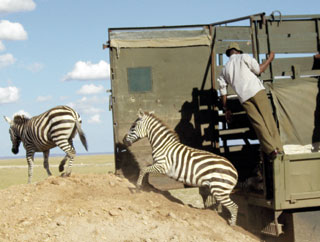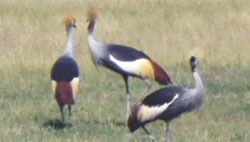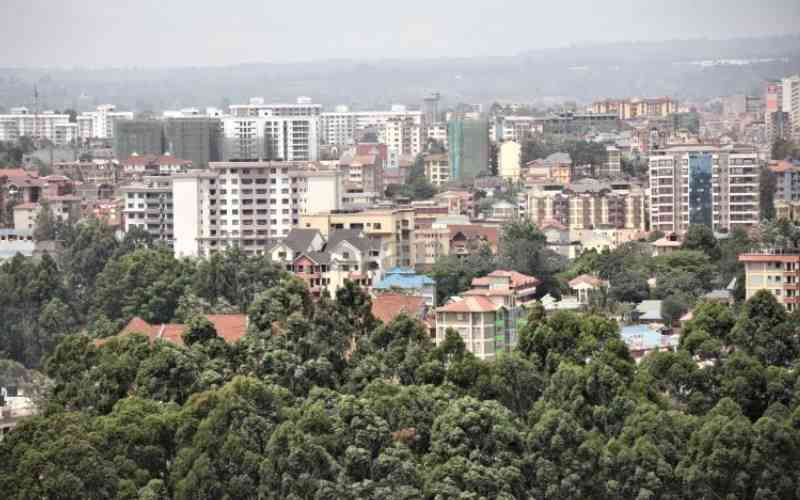By Ferdinand Mwongela
I have heard a lot about Amboseli National Reserve (formerly Amboseli National Park). From her famous elephants to the view of the snow-capped peak of Mt Kilimanjaro, the park is one you can’t miss to visit.
It is Kenya’s most spectacular displays of wildlife — lion, elephant, leopard, cheetah, and buffalo creating Kenya’s most sought after photographer’s parade.
 |
Translocated Zebras disembark. |
So when a chance to witness the just concluded aerial wildlife census by the Kenya Wildlife Services came, I didn’t hesitate.
Amboseli lies about 250km from Nairobi on the border with Tanzania at the foot of Africa’s highest mountain, Kilimanjaro, whose highest point, Kibo, peeps beautifully from the clouds especially in early mornings and evenings.
On this Sunday evening, the clouds are ominous with rain. With nothing much to see I opted to sleep early. Little did I know that the rains would affect the census the following day.
After a few hours delay due to poor weather the census kicked off in earnest. Together with a team of elephant researchers and the Amboseli elephant research project we boarded four small aircrafts for a flight before heading back to their camp about three kilometres from Ol Tukai Lodge where we were staying.
The camp is in the middle of the park and without a fence. One practically lives with the animals, it’s no place for the faint hearted. The elephant bones arranged outside showed their dedication to this large animal. The thought of an elephant bursting through the bushes is enough to give even the mightiest an uncomfortable feeling in the pit of the stomach.
Even a little rustle in a nearby bush made my heart race, how I longed for the comfort of my house in Nairobi, the noise and pollution notwithstanding.
The following day, we opted for a game drive, taking the meandering circuits around the park, looking for animals. At Longinye swamp, we came across a herd of buffalos grazing in the swamp. They glared balefully at our intruding party probably wondering why humans could not just mind their own business.
A few metres away, a herd of elephants was grazing too. Beside the swamp, indications of last year’s crippling drought were still evident as remains of an elephant lay on the parched ground. Ironically, in dry season, the swamps increase in size as the ice on Mt Kilimanjaro melts flowing into the low-lying basin in the park.
As we drive around the park, dark clouds can be seen gathering around Mt Kilimanjaro threatening to release its contents. Fortunately it only rains in the distance with gusts of wind raising dust around us.
I am keen on finding Zebras and Wildebeest following reports that the herbivore population in the park had been decimated. This we soon do as we sight some of them frolicking in the dust. Further on, impalas graze raising their heads to occasionally scan the horizon for predators.  |
Birds roam the Amboseli. Photo: Ferdinand Mwongela/Standard |
It is said that Amboseli has about 1500 elephants, the largest number in all Kenyan parks and reserves per square metre. We soon prove this as we stumble upon herds after every few kilometres.
The Observation hill
Being on the border, animals cross between the two countries at will. In the dry season, the herds are found in the low-lying Amboseli but retreat to higher ground in Tanzania at the foot of Mt Kilimanjaro in the wet season.
Our driver decides to head straight for the highest point in Amboseli, the Observation Hill where one can see the entire park. Our eyes are now peeled looking for the king of the jungle, the lion. We soon hit pay dirt. About 500 metres from the road, a lion is stalking a herd of impala who by now are alert, their heads held high. We, however, can only see a small speck as the distance is too far. As tourist vans slowly gather around waiting for the inevitable dash, we move on towards Observation Hill hoping that we will have a chance to see the lion at close quarters.
Time, however, beats us and we have to head back, promising ourselves that the next day we will complete our mission. This we did on the third day after the Deputy park warden Adan Kala gave us a driver and a guide back to the place where we had seen the lions. He tells us that this pride has about 16 lions who share a love for the spot.
Determined, we drive straight on with a few brief stops for photos. Another herd of elephants passes very close and in our open vehicle we feel thoroughly exposed. We slow down to let them pass. They, however, start trumpeting, signalling danger and we know the lions are around. The young ones move quickly to the middle of the herd. Back to the lions’ den referred to as Makindu due to the coniferous plants all around here, we slowly approach, looking for any sign of the lions. Soon we spot two cubs lying in a clearing, a big lioness watching over them. About 50 metres away, a herd of impala is carefully watching the bushes, most likely not seeing the lions aware all the same.
Right then I did not feel very safe knowing that there are at least ten other lions somewhere in the shrubs. As we went closer, another lioness, who was playing with a cub hidden, comes into sight. The cubs move away from us and put the lionesses between them and us. When a third lioness appears; I know the bushes are teaming with lions. A low grunt from one was enough and we were soon on our way after snapping a few cowardly pictures.
Aero gymnastics
Elsewhere, the aerial census went on well. Preliminary results trickling indicated that the animals were present in good numbers and the drought had hardly put a dent. When we finally take to the skies, I am worried about the manoeuvres I see the pilots doing in the air not sure my stomach would contain the air gymnastics.
From the air, in a small KWS aircraft, the vast plains roll open, mirrored beautifully in the setting sun with Mt Kilimanjaro in the background. Below us, animals graze unhurriedly.
As luck would have it, the KWS brought in several trucks of zebras being relocated to the park. It was a sight to behold as they dashed to freedom and some right into the mouths of predators.
 The Standard Group Plc is a multi-media organization with investments in media
platforms spanning newspaper print operations, television, radio broadcasting,
digital and online services. The Standard Group is recognized as a leading
multi-media house in Kenya with a key influence in matters of national and
international interest.
The Standard Group Plc is a multi-media organization with investments in media
platforms spanning newspaper print operations, television, radio broadcasting,
digital and online services. The Standard Group is recognized as a leading
multi-media house in Kenya with a key influence in matters of national and
international interest.
 The Standard Group Plc is a multi-media organization with investments in media
platforms spanning newspaper print operations, television, radio broadcasting,
digital and online services. The Standard Group is recognized as a leading
multi-media house in Kenya with a key influence in matters of national and
international interest.
The Standard Group Plc is a multi-media organization with investments in media
platforms spanning newspaper print operations, television, radio broadcasting,
digital and online services. The Standard Group is recognized as a leading
multi-media house in Kenya with a key influence in matters of national and
international interest.











